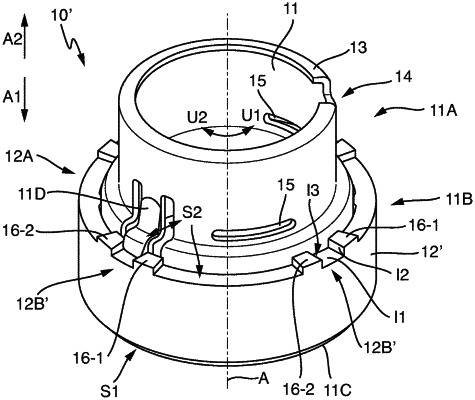| CPC G01D 5/12 (2013.01) [B62D 15/021 (2013.01); G01D 11/30 (2013.01)] | 11 Claims |

|
1. A magnet assembly for a sensor device for detecting a measurement variable characterizing a rotation state of a steering shaft of a motor vehicle, the magnet assembly comprising:
a sleeve; and
a magnetic element, which is connected in a form-fitting manner to the sleeve,
wherein the sleeve is for connecting the magnet assembly to a first part of the steering shaft and has at least one stop flange, which extends outwards in the radial direction in a radial plane, for axially securing the magnetic element in a first axial direction,
wherein the magnetic element is one of: sleeve-shaped, annular design, a magnetic ring, and a magnetic sleeve, and has a first end side, a second end side and a magnetically effective magnetic portion in between the first end side and the second end side, and
wherein the magnetic element is arranged concentrically with respect to the sleeve and, with its first end side, is at least partially supported axially on the stop flange and is thereby secured in the first axial direction, and
wherein the magnetic element is secured in a second axial direction and in a first circumferential direction and in a second circumferential direction by at least one latching means engaging in a recess which is open in the axial direction and has a plurality of inner surfaces, wherein a first inner surface of the recess forms a stop surface in the second axial direction and secures the latching means in the second axial direction,
wherein a second inner surface of the recess forms a stop surface in the first circumferential direction and secures the latching means in the first circumferential direction, and a third inner surface of the recess forms a stop surface in the second circumferential direction and secures the latching means in the second circumferential direction, and
wherein the at least one recess is formed by an end surface portion of the second end side of the magnetic element and by two projections of the magnetic element, said projections bordering said end surface portion on the outside in each case in the circumferential direction and extending in each case in the axial direction away from the end surface portion on the second end side.
|